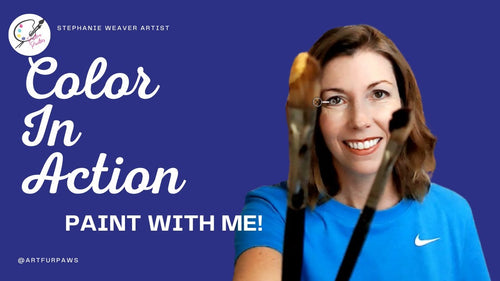*Please note, this article is referring to copyright filings in the United States. The laws vary from country to country. Also, I am not a lawyer, if you have questions please consult your attorney, if you don’t have one I do recommend my lawyer, Kiffanie Stahle and her online community designed for us creatives.
Is Copyrighting Your Artwork Worth It?
This year I’ve learned more about copyright law than I wanted to, much in part due to necessity rather than desire.
For ease of reading, I'm going to call the person who used my artwork "The Unoriginal", and as you read more you'll understand why.
As you know I teach artists how to paint not only in person but also through video tutorials, and one of my students was taking the artwork from the classes/workshops, and then selling the works and creating products using my designs and in several instances, the artwork was based on photos that belonged to me.
Now, I’ll be honest, I really didn’t care too much in the beginning because most people everyone start by copying in order to find their style and voice....but most people recognize they shouldn't sell the artwork they emulate/imitate. I mean seriously, there is a book called "Steal Like an Artist" (Amazon affiliate link). BUT the difference was, 'The Unoriginal' was that there was no original concept or diversion from my work to find their own voice.
AND after a couple of other artists pointed out that 'The Unoriginal' was selling at juried shows not only my work but another artist's work I thought “I guess 'The Unoriginal' doesn’t know what they are doing is wrong”.
- I just assumed people learn a lesson about plagiarism in school....apparently not...
So I and the other artist sent 'The Unoriginal' a pleasant email educating the person on the fine laws of copyright infringement.
In case you are wondering, is it ok to sell artwork created from an art class or workshop - the answer is no. (I’ve cited below portions of the Copyright.gov compendiums for your reading pleasure as to what constitutes original artwork:) )
BUT THEN, 'The Unoriginal', had the audacity to send me and the other artist a cease and desist letter for defamation of The Unoriginal’s name because they apparently take their 1.5 years of painting very seriously.
Are you FU@#$!!NG kidding me! - Is what I actually said out loud when I received the email from 'The Unoriginal's" lawyer friend.
Yes, I do cuss every so often when there are just no other words...
The letter got me more pissed than The Unoriginal reselling my art.
I mean seriously, the nerve!
- But that was my pain and I believe that with all piles of shit, some good things can grow :). Lessons learned.
So what did I do about 'The Unoriginal'?

- I removed 'The Unoriginal' from the Positive Painters Online Artist Community. Here we respect and honor each other’s work.
-
I consulted with a lawyer friend.
She gave me sage advice, while yes I am technically correct, in truth 'The Unoriginal' wasn’t worth the time, effort, or most importantly, money. (To sue 'The Unoriginal' would cost anywhere from $2000 to $4000 in legal fees alone). -
I created an awesome piece of artwork that is completely off-brand for me but gave a powerful message - shown above.
The piece is titled, “From the Legal Offices of Go Fuck Yourself”. It was definitely an emotionally inspired piece (you can read more about it on Facebook - like and follow please :) ). - I began teaching my fellow creatives about copyrights as quickly as I learned: My experience with 'The Unoriginal' led me on a crusade to provide knowledge to my fellow artists and creatives!
So good things did come out of the experience :) .
Why should you file copyright?
Here’s why: without a filed copyright, even if you win damages for the infringement of your art, the court will not award attorney’s fees, which can oftentimes cost more than what is awarded.
AND with the new amendment that Trump enacted in favor of us little guys on 12/27/2020, called CASE Act that was pushed through by PPA (Professional Photographers of America), we little guys can now take the unoriginal thieves to small claims court instead of waiting on the Federal Court that only the big guys like Metallica can afford (if you remember, Metallica took down Napster years ago for copyright infringements)..
What this means, thanks to Trump’s team enacting the CASE Act we little guys can now go after violators starting in December of 2021 and request a max penalty of $15,000 statutory damages per work infringed, with a total of $30,000 possible in any one proceeding (excluding attorneys’ fees and costs). Instead of spending a minimum of $10k just to get into Federal Court!!!
So! Set up a Copyright account today with http://www.Copyright.gov!!!
How to copyright your artwork
I’m not going to sugar-coat it; as you can see in my somewhat sarcastic walkthrough of submitting your copyright to the U.S. the copyright office website is not at all user-friendly.
But don’t let that deter you.
After you file a couple of these, you’ll get used to it and it will be easy peasy. With my organizational methods, I was able to submit 50 paintings for copyright in a day, I stopped when I hit my budget limit.
The copyright office has a distinguishing requirement for artwork: is the work published or unpublished? And depending on which one you have, there are different requirements.
Published means that the artwork has been printed, or made for sale in tangible form, or offered for licensing. The published requirement was a little confusing, and so I called the Copyright office and came to understand that Published means that it’s been sold or was printed on anything with the intention of selling it.). So with this requirement, I had to submit any piece that had sold either the original or had a print made (like my Caticorn pillow), individually.
For unpublished works, you can group up to 10 pieces of art on one registration (and note, Photography has different limitations).
Note: At the time of writing this, 7/5/2021, published works have to be submitted one at a time and each submission costs $. So plan your budget and your work accordingly. (In the video, I give tips on how I use Google Drive to organize my submissions).
What happens next and when does artwork become a registered copyright?
This was a big question for me because I had about 50 pieces that hadn’t seen the light of day that I’d like to start creating products for and selling. This is what I found out, thanks to Kiffanie’s video tutorial (link here).
Essentially as soon as the copyright office sends me an email that they have received my images, my work is registered with the copyright office.
YEAH - now I can sell it and create prints!
The paper certificate of registration that you receive in the mail can take up to 2 - 6 months.
How do I keep track of Copyrights?

I use 2 tools:
- Google Drive
- Airtable (affiliate link)
How I use Google Drive for managing copyrights of artwork:
I store images that are waiting for copyright in a folder, smartly labeled, “Submit for Copyright”. Once I have 10 images in the folder, I submit them for copyright.
Once I’ve submitted the images to the copyright office, I then move all the images to a new folder labeled with the copyright number to a folder called “Submission Complete”
How I use Airtable for managing copyrights of artwork:
I’ve created a database in Airtable that I use for Inventory management. It is in Airtable that I keep track of where the piece is (gallery a, b, or c), the price, the cost, whether it sold and to whom, and the copyright numbers.
When I receive the copyright approval letter from the US copyright office, I scan it and save the image in both Google Drive and Airtable.
Conclusion
In our inaugural podcast episode of Artists Soar, myself, Rachel Harchanko and Julie ‘Jules’ McCullough discuss what artists should do to protect their works and what they should do if and when a copycat happens. I’d also recommend listening to this podcast for some gold nuggets of info.
And I’m going to leave you with this note:
There will always be copycats, there will always be thieves, but there is no one as original as what you have the ability to create - so keep creating, copyright your creations and keep sharing.
____
Can an artist sell artwork created in a workshop or class?
Here are the specific excerpts from Copyright office on what makes an original piece - enjoy!:
Per the Copyright.gov Compendium Chapter 900, about students copying non-independent works:
905 Copyrightable Authorship in Visual Art Works The U.S. Copyright Office may register a visual art work (i) if it is the product of human authorship, (ii) if it was independently created (meaning that the work was not merely copied from another source), and (iii) if it contains a sufficient amount of original pictorial, graphic, sculptural, or architectural authorship. The Office reviews visual art works consistent with the general principles set forth in Chapter 300 (Copyrightable C O M P E N D I U M O F U . S . C O P Y R I G H T O F F I C E P R A C T I C E S , Third Edition Chapter 900 : 8 01/28/2021 Authorship: What Can Be Registered), as well as the guidelines described in this Chapter.
In all cases, the work “must be original, that is, the author’s tangible expression of his [or her] ideas. Such expression, whether meticulously delineating the model or mental image or conveying the meaning by modernistic form or color, is copyrightable.” Mazer v. Stein, 347 U.S. 201, 214 (1954).
Further, in regards to derivative artwork and using step-by-step directions provided by instructor lead courses
907.1 Copyrightable Authorship in Derivative Works A derivative visual art work is a work based on or derived from one or more preexisting works. A derivative work may be registered if the author of that work contributed a sufficient amount of new authorship to create an original work of authorship. The new material must be original and copyrightable in itself.
Examples of works that cannot be registered as derivative works, because they contain no new authorship or only a de minimis amount of authorship include the following types of visual art works: • Photocopies and digital scans of works. • Mere reproductions of preexisting works.
And another section Compendium Chapter 300,
308 The Originality Requirement Originality is “the bedrock principle of copyright” and “the very premise of copyright law.” Feist Publications, Inc. v. Rural Telephone Service Co., Inc., 499 U.S. 340, 347 (1991) (citation omitted). “To qualify for copyright protection, a work must be original to the author,” which means that the work must be “independently created by the author” and it must possess “at least some minimal degree of creativity.” Id. at 345 (citations omitted). These requirements are discussed in Sections 308.1 and 308.2 below.
308.1 Independent Creation The term “independent creation” means that the author created the work without copying from other works. See Feist, 499 U.S. at 345.
313.4 Works That Do Not Satisfy the Originality Requirement As discussed in Section 308, the Copyright Act protects “original works of authorship.” 17 U.S.C. § 102(a) (emphasis added). To qualify as an “original” work of authorship, the work must be independently created and must contain some minimal amount of creativity. The U.S. Copyright Office will not register works that do not satisfy these requirements.






































